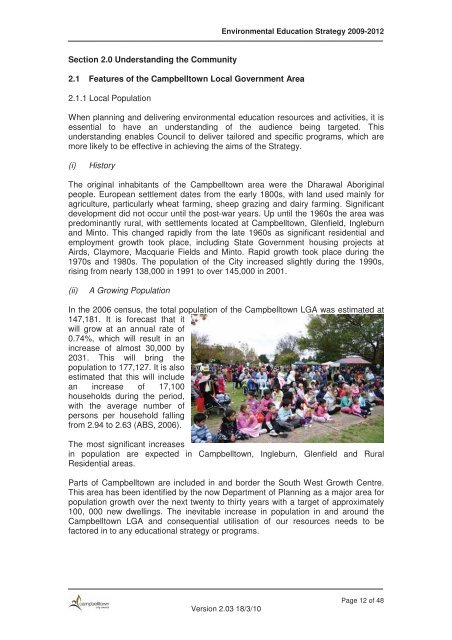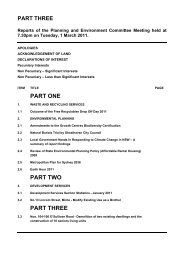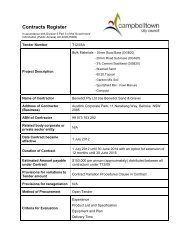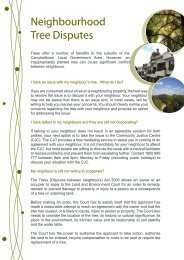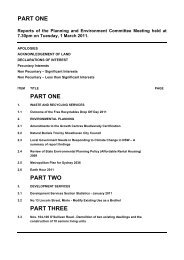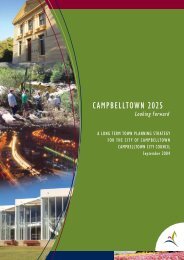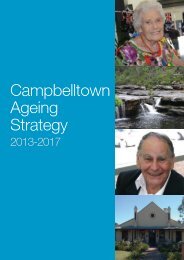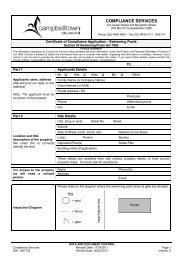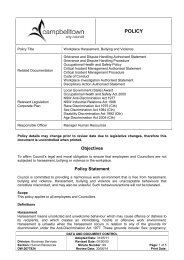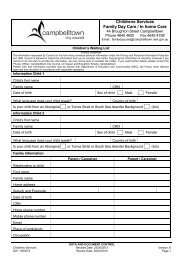Environmental Education Strategy - Campbelltown City Council ...
Environmental Education Strategy - Campbelltown City Council ...
Environmental Education Strategy - Campbelltown City Council ...
- No tags were found...
You also want an ePaper? Increase the reach of your titles
YUMPU automatically turns print PDFs into web optimized ePapers that Google loves.
<strong>Environmental</strong> <strong>Education</strong> <strong>Strategy</strong> 2009-2012Section 2.0 Understanding the Community2.1 Features of the <strong>Campbelltown</strong> Local Government Area2.1.1 Local PopulationWhen planning and delivering environmental education resources and activities, it isessential to have an understanding of the audience being targeted. Thisunderstanding enables <strong>Council</strong> to deliver tailored and specific programs, which aremore likely to be effective in achieving the aims of the <strong>Strategy</strong>.(i)HistoryThe original inhabitants of the <strong>Campbelltown</strong> area were the Dharawal Aboriginalpeople. European settlement dates from the early 1800s, with land used mainly foragriculture, particularly wheat farming, sheep grazing and dairy farming. Significantdevelopment did not occur until the post-war years. Up until the 1960s the area waspredominantly rural, with settlements located at <strong>Campbelltown</strong>, Glenfield, Ingleburnand Minto. This changed rapidly from the late 1960s as significant residential andemployment growth took place, including State Government housing projects atAirds, Claymore, Macquarie Fields and Minto. Rapid growth took place during the1970s and 1980s. The population of the <strong>City</strong> increased slightly during the 1990s,rising from nearly 138,000 in 1991 to over 145,000 in 2001.(ii)A Growing PopulationIn the 2006 census, the total population of the <strong>Campbelltown</strong> LGA was estimated at147,181. It is forecast that itwill grow at an annual rate of0.74%, which will result in anincrease of almost 30,000 by2031. This will bring thepopulation to 177,127. It is alsoestimated that this will includean increase of 17,100households during the period,with the average number ofpersons per household fallingfrom 2.94 to 2.63 (ABS, 2006).The most significant increasesin population are expected in <strong>Campbelltown</strong>, Ingleburn, Glenfield and RuralResidential areas.Parts of <strong>Campbelltown</strong> are included in and border the South West Growth Centre.This area has been identified by the now Department of Planning as a major area forpopulation growth over the next twenty to thirty years with a target of approximately100, 000 new dwellings. The inevitable increase in population in and around the<strong>Campbelltown</strong> LGA and consequential utilisation of our resources needs to befactored in to any educational strategy or programs.Version 2.03 18/3/10Page 12 of 48


